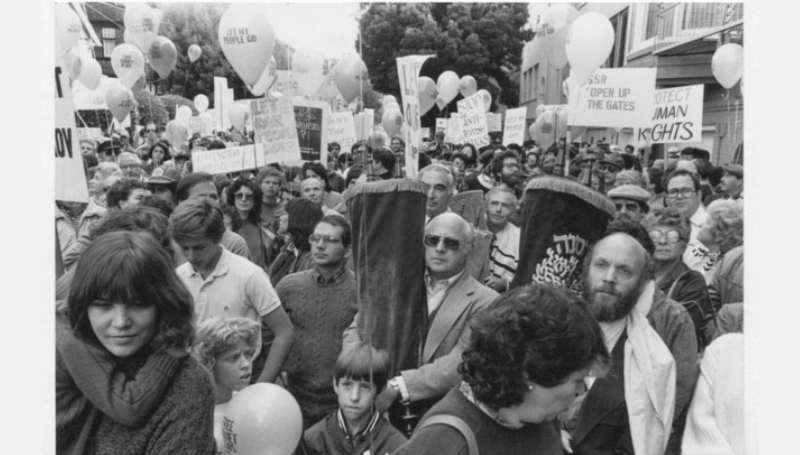Tova Benjamin
Jewish Currents, May 23, 2022
“While many American and Israeli Jews believed themselves altruistic saviors of their Soviet counterparts, they were also political actors whose activism advanced their own countries’ domestic political agendas. “
THE LARGEST Jewish political rally in United States history took place on a mild winter day, December 6th, 1987, when a quarter of a million people gathered on the Washington Mall for an event advertised as a “Freedom Sunday for Soviet Jews.” People of all ages arrived from cities across the US holding signs bearing the faces of “prisoners of Zion” and wearing pins with slogans like “Let Freedom Ring for Soviet Jews.” On the main stage stood a giant menorah and a large banner with the words “Let Our People Go” scrawled over red brick, invoking the biblical slavery in Egypt. Between speeches, the crowd sang inspirational songs, from the civil rights gospel tune “We Shall Overcome” to the movement’s Hebrew anthem “Am Yisrael Chai,” accompanied by guitar and tambourine.
Kicking off a program of speakers that included Vice President George H.W. Bush as well as several members of congress, Morris Abrams—the chairman of the National Conference for Soviet Jewry (NCSJ), which had helped organize the event—reminded the crowd of the movement’s broad aims. “We are here to insist that [the Soviet government] comply with the human rights promises [it] made in Helsinki!” he declared, inviting cheers from the crowd, which waved American and Israeli flags overhead. “We are here to affirm our ties to Soviet Jews, cut off from their brethren, persecuted, and denied the right to practice their religion!” The memory of the Jewish genocide in Europe haunted the speakers’ appeals. When Nobel laureate and Holocaust survivor Elie Wiesel spoke, he addressed the rally’s subtext directly: “It is now clear that had there been such a demonstration of Jewish and human solidarity and concern in 1942, 1943, and 1944, millions of Jews would have been saved,” he said. “But too many of us were silent then. We are not silent today.”
The 1987 rally occurred at the peak of what has come to be known as the “Soviet Jewry movement,” or the “Save Soviet Jewry movement,” an international effort that brought together the world’s three largest Jewish populations—in Israel, the US, and the Soviet Union—during the years of the Cold War. From the 1960s until the collapse of the USSR in 1991, Jewish activists in the US and the new State of Israel lobbied for the right of Jews to leave the Soviet Union. Academics debate when the organizing began and whether it constituted a single, unified movement or many discrete ones. What is clear is that the effort gained the most momentum in the US, where a wide range of establishment organizations, militant Jewish student groups, and religious leaders devoted themselves to the cause, sometimes clashing in their aims and tactics. In its heyday, the movement’s rallies and protests attracted extensive media attention and touched virtually every aspect of American Jewish life.
Today, the movement is remembered in the popular imagination, by liberals and conservatives alike, as a unique moment when Jews across the world came together for human rights: “the last event that united practically all Jews, independent of their political interests and religious views,” in the words of Nati Cantorovich, an official involved in Nativ, the Israeli agency dedicated to Soviet Jews. Contemporary journalists and academics defer to activists’ characterization of their decades-long campaign as the “Jewish civil rights movement.” In a blurb for New York Times editor Gal Beckerman’s sweeping 2010 account, When They Come For Us, We’ll Be Gone: The Epic Struggle to Save Soviet Jewry, author Cynthia Ozick placed the movement “[a]mong the great liberation strivings of the twentieth century,” comparing it to struggles against apartheid in South Africa and British colonialism in India.
To Read the full article click Here


